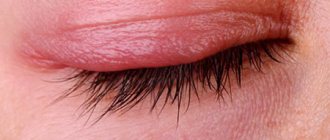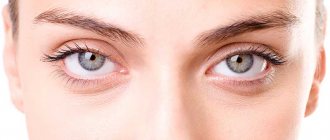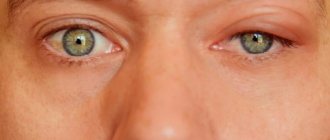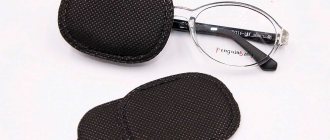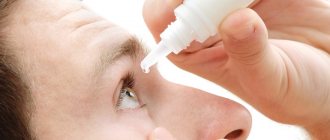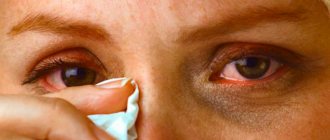Blepharitis is a common ophthalmological disease in which there is inflammation of the edges of the eyelids. The inflammatory process is chronic and progressive, difficult to respond to conservative therapy and can provoke the development of serious visual problems. Treatment of blepharitis is a long, complex process, which, in addition to medications, should include massage.
Blepharitis is an eye disease in which there is bilateral inflammation of the edges of the eyelids. The pathological process is characterized by a long, recurrent course and a high probability of complications. The main cause of inflammation of the eyelids is the activation of demodex mites. Sometimes the disease occurs due to infection by other mites, fungi or bacterial infections. There are also non-infectious blepharitis that develop against the background of other eye pathologies or allergic reactions.
Types of blepharitis
Taking into account where the disease is localized, the following types of blepharitis are distinguished:
- Front edge. The edge of the eyelid with eyelashes becomes inflamed.
- Posterior edge. The meibomian glands become inflamed in the middle of the eyelid. The pathological process may spread to the conjunctiva or cornea.
- Angular. The corner edges of the eye become inflamed.
Most often, doctors diagnose both anterior and posterior marginal blepharitis, in which the entire eyelid is affected. Taking into account the nature of the course, the following types of blepharitis can be distinguished:
- Scaly. Accompanied by the formation of crusts along the edges of the eyelids, often combined with dermatitis of the scalp and face of the seborrheic type. Long-term lack of treatment can cause eyelash loss and eyelid inversion.
- Ulcerative. It is characterized by inflammation of the eyelash follicles, accompanied by the formation of purulent bleeding ulcers, in place of which small scars remain. The prolonged course of the pathology provokes impaired growth and loss of eyelashes.
- Allergic. It occurs against the background of an allergic reaction and is often combined with conjunctivitis.
- Demodectic. It develops due to the activation of demodex mites, which can only be seen under a microscope. Accompanied by severe itching and hyperemia of the eyes, the separation of sticky fluid, which then turns into interciliary scales.
In rare cases, acne, meibomian or mixed type of blepharitis can be diagnosed. The specifics of therapy depend on the type of pathology.
Causes of belepharitis
What is manual sugaring technique?
There are several causal factors that cause this process; only by identifying them can we talk about high-quality and highly effective home treatment:
- which lasts for a long time;
- allergic phenomena and conditions;
- use of low-quality cosmetics;
- abuse of sun exposure;
- eye diseases: astigmatism, myopia, farsightedness;
- eyelid diseases, including tick-borne diseases;
- problems with the gastrointestinal tract: colitis, gastritis, pancreatitis, parasites, allergies;
- autoimmune reactions due to chronic inflammation.
There are many causative factors of the disease, and when searching for actual treatment, it is important to identify the main ones. https://www.youtube.com/embed/Fp4IaWiPI1Q
Demodectic blepharitis is an inflammation of the eyelid margins, which is caused by opportunistic mites of the genus Demodex. Interestingly, microorganisms live in the ducts of the meibomian glands in more than 90% of the entire adult population, but the disease does not appear in everyone.
The fact is that the tick begins to actively reproduce in favorable conditions, for example, when the host’s immunity decreases, as well as under the influence of various unfavorable factors (high temperature, bright sun, etc.).
The amazing results of the federal program to combat vision loss are paying off.
staying at elevated temperatures for a long time; infrared and ultraviolet radiation; weakened body resistance; long-term use of hormonal ointments and antibiotics; skin prone to acne; an excess of various procedures in beauty salons (facial cleansing, peeling, solarium and others); stressful situations; eye diseases and operations; various other diseases; unfavorable living conditions.
The development of blepharitis can be due to a variety of reasons. Infectious blepharitis is caused by bacteria (epidermal and Staphylococcus aureus), fungi, mites; non-infectious - allergic agents, ophthalmological diseases.
Damage to the skin of the eyelids by demodex mites. Many people have these parasites, and they live in hair follicles, on the surface of the skin, and in the sebaceous glands. If immunity decreases, mites begin to actively multiply and as a result end up on the skin of the eyelids. This is why demodectic blepharitis develops. Increased sensitivity to certain irritants. Such substances include dust, animal hair, pollen, and cosmetics. In this case, a person experiences allergic blepharitis, which is often accompanied by inflammation of the mucous membrane of the eye. Certain diseases contribute to allergization of the body - gastritis, diabetes, cholecystitis. Eye muscle tension. Blepharitis often appears in people suffering from farsightedness who do not use glasses. Constantly tense muscles often get tired, a person experiences a certain discomfort, which is why he rubs his eyes with his hands. It is for this reason that infection occurs, contributing to the development of blepharitis.
The causes of blepharitis are varied. The edges of the eyelids may be affected by demodex mites.
In 80% of people, these mites live on the surface of the skin, in the sebaceous glands, and in hair follicles. When the body's resistance decreases due to overwork, hypothermia or any previous disease, the mites become active, multiply intensively and, when they get on the skin of the eyelids, on the eyelashes, cause demodectic blepharitis.
Blepharitis often accompanies farsightedness and astigmatism, as well as severe dry eye syndrome.
Symptoms
The symptoms of eye blepharitis develop rapidly, causing the patient a lot of inconvenience and discomfort. The disease can be suspected by the following symptomatic manifestations:
- hyperemia, swelling of the eyelids,
- severe itching along the eyelash edge,
- heaviness, discomfort in the eyes,
- yellowish foamy discharge,
- formation of dry scales between the eyelashes,
- rapid eye fatigue,
- photophobia.
The following symptoms may also occur with this disease:
- sticking, loss or ingrown eyelashes,
- change in the shape of the eyelid,
- formation of abscesses.
Blepharitis of the eye is often accompanied by blurred vision caused by the tear film that forms.
Symptoms of blepharitis
First stage: the patient feels severe itching and pain, in the morning the eyes are covered with a sticky suspension. Second stage: the eyelids turn red and swell, excess secretion from the sebaceous glands accumulates on the edges of the eyelashes, forming whitish growths, the eyes begin to get tired quickly. Third stage: if treatment is not started in time, the eyelashes will begin to fall out, and in their place, thinned, brittle ones will appear, directed in different directions. Tear production will increase, and mites will begin to provoke other diseases, such as keratitis, conjunctivitis, and stye. Advanced stages: demodicosis spreads to the skin of the face, where severely itchy patches of peeling form.
If you feel the first symptoms of the disease, you should immediately consult a specialist; self-treatment can lead to complications.
Thickening and feeling of heaviness of the eyelids. Itching in the eyes. Swelling and redness of the eyelids. Rapid eye fatigue. Loss of eyelashes, their abnormal growth. The appearance of scales on the eyelashes. High sensitivity to various irritants and bright light.
This disease is not classified as contagious. However, if a person is diagnosed with demodectic blepharitis. It is recommended to keep his personal belongings separate from those of other family members, as there is a risk of infection with dangerous ticks.
Demodectic blepharitis. This disease is caused by demodex mites. The main signs of this pathology are itching, thickening and redness of the eyelids.
Chronic blepharitis. Staphylococcus aureus often leads to the development of this pathology. This disease is accompanied by loss of eyelashes, itching in the eyes, and swelling of the eyelids. The eyes become watery and get tired quickly.
The course of any form of blepharitis is accompanied by typical manifestations: swelling and redness of the eyelids, itching, rapid eye fatigue and increased sensitivity to irritants (light, wind). Constantly forming tear film causes blurred vision.
Simple blepharitis is characterized by hyperemia and thickening of the edges of the eyelids, accumulation of whitish-gray secretions in the corners of the palpebral fissures, moderate redness of the conjunctiva, and dilation of the meibomian gland ducts.
With scaly blepharitis, scales of desquamated epidermis and epithelium of the sebaceous glands accumulate on the thickened and hyperemic edge of the eyelid, which are tightly attached to the base of the eyelashes. Skin scales are also found on the eyebrows and scalp. Seborrheic blepharitis may be accompanied by loss and graying of eyelashes.
The ulcerative form of blepharitis occurs with the formation of yellowish crusts, when removed, ulcers open. After the ulcerations heal, scars form, which disrupts the normal growth of eyelashes ( trichiasis). In severe cases, eyelashes may become discolored (poliosis) and fall out (madarosis), and the anterior lash line may become hypertrophied and wrinkled.
Demodectic blepharitis occurs with constant unbearable itching of the eyelids, more pronounced after sleep. The edges of the eyelids thicken in the form of a reddish ridge. In the daytime, there is a pain in the eyes, the release of a sticky secretion, leading to the drying of the discharge and its accumulation between the eyelashes, which gives the eyes an untidy appearance.
Symptoms of allergic blepharitis. in most cases, they appear suddenly and are clearly associated with some exogenous factor. The disease is accompanied by swelling and persistent itching of the eyelids, lacrimation, mucous discharge from the eyes, photophobia, and pain in the eyes. Allergic blepharitis is characterized by darkening of the skin of the eyelids (the so-called “allergic bruise”).
Blepharitis can occur with symptoms of conjunctivitis. dry eye syndrome, keratitis, acute meibomitis. development of chalazion, formation of barley, conflicts and corneal ulcers. threatening loss of vision. Almost always, blepharitis takes a chronic course and tends to recur over many years.
The benefits of massage for blepharitis
Massage for blepharitis is an important part of conservative treatment. Correctly performed massage actions help achieve the following results:
- blood circulation of the eyelid improves,
- nutrition of the eye is enhanced,
- inflammation is relieved,
- the tone of the eye muscles increases,
- fluid outflow improves.
Massage for blepharitis stimulates the functioning of nerve fibers, which improves the functioning of the eye, removes toxins and eliminates symptomatic manifestations such as swelling, redness and itching. In addition, massage actions promote better penetration of eye drops and ointments, speeding up the healing process.
The benefits of massage for such a disease are invaluable, but this method of treatment can only be used with the permission of a doctor.
Glass wand massage
This is the most common type of massage for blepharitis, which is performed using a special glass rod. The glass wand massage technology looks like this:
- An anesthetic is instilled into the eye to reduce pain.
- Pull the eyelid slightly and insert a glass spatula under it.
- Press the shoulder blade with your finger and begin to gently move it from the inner corner of the eye to the outer corner. During the procedure, fluid may be released, which is normal.
- Massaging movements with a spatula should be done on the lower and upper eyelids.
- At the end of the manipulations, the edges of the eyelids should be treated with essential alcohol, the prescribed drops should be instilled, or an ointment should be applied.
Massage for blepharitis with a glass rod should be performed for 2-3 weeks.
Drug therapy
The essence and mechanism of action of massage on the body
To treat blepharitis of the eyelids, lotions and compresses are used. Patients need to regularly perform hygiene procedures by doing the following:
- Apply compresses. Cotton pads are soaked in warm antiseptic solutions. Place on eyelids for 5–10 minutes.
- Rinse eyes if blepharitis is infectious. Antiseptic solutions remove pathogenic exudate containing mites, bacteria, viruses, allergens, and toxins.
- Blink rapidly for 3-5 minutes. Gymnastics strengthens muscle tissue and increases the elasticity of the skin of the eyelids.
- Self-massage your eyelids. Ointments and creams are distributed over the skin, massaging the edges of the eyelids. Perform two sessions per day for 3–5 minutes. Treatment lasts for months. If the disease reappears, the massage is resumed.
Massage
After performing hygiene procedures, massage with a glass rod with different ends (sold in a pharmacy). The tip with the ball is used to apply ointment. Use a spatula to massage the eyelids.
Massaging the eyelid, the spatula is moved to the edge of the eye. If the disease is not advanced, tiny bubbles of exudate emerge from under the eyelid. Otherwise, a white secretion in the form of flagella is released.
The eyelids are massaged alternately: first one, then the other. After the procedure, they are treated with medications prescribed by the doctor. A cotton swab is moistened with an antiseptic, and the excess is removed so that it does not get on the eyeball. Clean the eyelids from sebaceous secretions by moving the stick from the inner to the outer edge of the eye.
After cleaning, medicine is instilled into the eyes and treated with ointment. Use medications prescribed by a doctor. You cannot choose antiseptic and antibiotic drugs on your own. They can have dangerous side effects, cause irritation or an allergic reaction.
Therapy for allergic blepharitis
First of all, they try to get rid of the allergen. If the provoking factor cannot be eliminated, antiallergic drugs are used to treat eye blepharitis: Lecrolin or Alomide, corticosteroid ointments for the eyes. If an infection occurs, use Dex-gentamicin or Maxitrol.
Therapy for ulcerative blepharitis
Pay attention to eyelid hygiene. Apply lotions to the eyelids or treat them with ointment
To do this, take drugs with corticosteroids or antibiotics: Dex-gentamicin, Neomycin. They soften the crusts and wash away the pathogenic exudate.
After cleaning, Dex-gentamicin is instilled into the eyes. For ulcers on the cornea, use Solcoseryl or Vitasik.
Treatment of seborrheic blepharitis
The eyelids are cleaned with Hydrocortisone or Oftagel. If conjunctivitis is added to blepharitis, Dexamethasone is used.
Therapy for demodectic blepharitis
To destroy mites, soak a cotton pad in saline solution and clean the eyelids with it. The procedure is done twice a day. The edges of the eyelids are treated with Hydrocortisone or Dex-gentamicin. Ointments destroy ticks. If conjunctivitis occurs, Dexapos is prescribed.
Finger massage
Massaging movements with the fingertips improve metabolic processes in the eye and help relieve inflammation. How to massage the eyelids with blepharitis yourself? Finger massage is performed as follows:
- The first step is to thoroughly wash your hands and treat your eyes. If necessary, administer an anesthetic.
- Close your eyes and make stroking movements with your fingers from the inner corner of the eye to the outer.
- After 60 seconds of stroking, lightly press on the edges of the eyelid, provoking the separation of secretory fluid.
- Perform stroking movements again, relaxing your eyes.
- At the end of the massage, treat the edges of the eyelids with essential alcohol, rinse your eyes with an antiseptic and apply the prescribed medicine.
During massaging, do not apply sharp, intense pressure. After the procedure, you need to wash your face and hands well, then give your eyes a rest.
Solutions to the problem
Depending on the cause of drooping eyelids, there are several options to get rid of the problem. All methods differ in effectiveness, cost and speed of results.
Surgical method
A scalpel is the most effective method, but it is used only in extreme cases. This is the only option to eliminate the congenital problem. If a drooping eyelid appears as a result of aging or for other reasons, then it can be solved with the help of a cosmetologist, home gymnastics, and special medications.
There are several options for how to remove a drooping eyelid through surgery. The first is suitable for those whose eyelids are inactive. In this situation, the surgeon either shortens the muscle that has weakened and cannot support the eyelid, or suspends the drooping eyelid from the frontalis muscle.
If we are talking about age-related changes that have led to atrophy of the muscles of the upper eyelid, then surgeons perform blepharoplasty. This method involves the following steps: the specialist makes an incision in the corner of the eyelid, after which he removes excess skin and fiber.
Help from a cosmetologist
Modern cosmetology is full of a wide variety of procedures, including those that will help get rid of the impending eyelid without surgical intervention. Cosmetologists offer 2 options:
- Botox. Botox injections have become one of the most popular procedures to solve aging problems, including ptosis. If the cause of drooping eyelids is wrinkles on the forehead, then Botox can easily cope with this.
- Mesothreads. The appearance of mesothreads was a real revolution in the world of cosmetology. This procedure came to replace plastic surgery. With the help of mesothreads, cosmetologists perform a facelift; eyelids can also be tightened. To do this, threads are inserted into the area of the temples and forehead.
In addition, there are special gymnastics, exercises, compresses and masks that can be done at home.
Solving the problem yourself
There are many tips and tricks on how to get rid of sagging eyelids at home. However, these methods are not as effective and efficient as the first two options, and therefore are most likely suitable for prevention rather than treatment. Although, if the problem is only in the initial stages, then with the help of gymnastics you can achieve good results.
If you do not want to become the owner of a sagging upper eyelid in old age, then you need to start exercising now. There are several options for gymnastics:
- Raise your head up, then lower your gaze to see your nose, hold your gaze for 10 seconds. The head should be motionless.
- Move your eyes first to the left, then to the right, then up and down, then diagonally and in a circle. Repeat the exercise several times until you feel slight muscle fatigue.
- Get a massage. To do this, wash your face and apply a light cream. It is not recommended to use oil or greasy products. After this, begin the procedure with clean hands. Use your ring finger to move from the nose to the temple, lightly pressing on the eyelid. In the overhanging area, you can increase the pressure.
One of the important rules for doing gymnastics is its regularity. Even if you have achieved results and the ptosis has significantly decreased or gone away completely, you should never stop exercising, as the problem may return.
Treating ptosis at home is also possible in other ways. You can get rid of the problem using various homemade cosmetics. The most common option is compresses. It is very simple to prepare a decoction at home. For this, use birch leaves, parsley and chamomile roots.
You can also get rid of ptosis using potato juice compresses. Regular ice will help relieve swelling in the morning. You need to wipe your eyelids with it. Watch your diet, too, as poor diet becomes a common cause of ptosis. Don't eat a lot of salty and sweet foods, try not to drink a lot of water at night.
Drug treatment of blepharitis
In addition to eyelid massage, various medications are prescribed for blepharitis. With this diagnosis, the ophthalmologist may prescribe the following medications:
- antibacterial, hormonal ointments: Furacilin, Tetracycline, Blefarogel,
- ophthalmic drops: Maxitrol, Dexapos, Albucid,
- antibacterial therapy: Phloxa, Tobrex,
- antiseptics for eye washing: Miramistin, Fluconazole.
If necessary, antihistamines, immunostimulants, or some other drugs may be prescribed. Additionally, folk remedies are recommended.
Hygiene measures
Regardless of the etiology of inflammation in blepharitis, it is important to maintain careful hygiene of the hands, face, and especially the eyelids. To do this, you must follow these rules daily:
- You can wash your face only with warm water.
- Every morning you need to clean the eyelash edges of the eyelid from crusts using a cotton pad soaked in a weak solution of baby shampoo.
- Rinse your eyes with cotton wool soaked in calendula infusion, moving from the outer edge to the inner.
- Apply a compress based on a decoction of calendula or chamomile to the closed eyelid.
- Do not touch your eyes and especially do massage with dirty hands.
During treatment for blepharitis, you need to pay great attention to personal hygiene, stop wearing cosmetics and wearing lenses.
